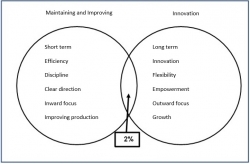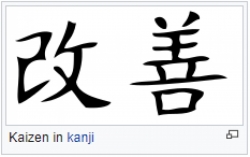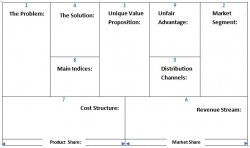This article uses parts of the book Great by Choice: Uncertainty, Chaos, and Luck—Why Some Thrive Despite Them All by James C. Collins and Morten T. Hansen.
"Victory awaits him who has everything in order — luck, people call it. Defeat is certain for him who has neglected to take the necessary precautions in time; this is called bad luck." - Roald Amundsen, the first to reach the South Pole.
A Short Prologue
A few weeks ago I met with Rona, a brilliant entrepreneur, and we discussed setting up her business. Towards the end of our meeting I suggested that, alongside starting her business, she could also take over her accounts management.
"Why?" she asked amazed. "That way you'll have better control of your expenses", I answered and added, "It's very simple, and will save you money too. When you have a small business it's important. "
"We'll see", Rona answered, "we'll cross that bridge when we get to it."
That phrase, "we'll cross the bridge when we get to it", is a common one, meaning – we don’t need to deal with a foreseen problem in advance, we can do that when it appears. This often used phrase is the antithesis of this article.
How Did Amundsen Reach the South Pole a Month Before Scott, and Come Back Alive?
In their book Great by Choice, James Collins and Morten Hansen describe the journeys undertaken by Roald Amundsen and Robert Falcon Scott to the South Pole in 1911. Amundsen reached his destination a month before Scott and came back alive, while Scott and his associates froze to death on their way back, while approximately 15 kilometers from their supply cache.
In the years before his journey, Amundsen, not knowing what he and his men will face, spend time with Inuit tribespeople – learning from them how they moved slowly to avoid excess perspiration which might turn to ice. He further learnt how to travel by dog-pulled sleds and adopted Inuit methods. He trained in order to be prepared for every conceivable situation he might encounter on his journey.
During the journey, too, Amundsen took precautions against unexpected developments. For example, he prominently marked his supply caches (meant for the journey back) with black flags, over a 10 kilometers wide stretch in case he'll be diverted in a storm.
Scott, contrastingly, did not use the years before his journey to prepare as Amundsen did. He didn't practice skiing nor did he live with Inuit tribes. He went on his journey to the South Pole equipped with "motor sledges" and pony horses. Unlike dogs, ponies sweat over the skin.
During the journey, that sweat turned to ice. The sleds' engines cracked in the first few days, and the ponies failed. Scott and his men progressed slowly, having to harness themselves to the sleds.
According to Collins and Hansen, Amundsen's philosophy was that you don’t need to become lost in a storm to know you need more than strength and resilience. You don’t need to go on a journey to Antarctica to learn to ski or hire excellent dog-sled drivers. You should train energetically, constantly, so that when conditions change for the worse you'll be able to draw on a deep reserve of strength.
Scott, who didn't prepare for his journey as Amundsen did, wrote in his diary "Our luck in weather is preposterous ". Later he added "It is more than our share of ill-fortune… How great may be the element of luck!"
Who Are the 10Xers the Book Discusses?
Collins and Hansen set three criteria for such companies:
- The company consistently produced especially good results, for 15 years or more, in relation to the general stock-market and their specific industry.
- The company achieved these results in a turbulent environment beset by uncontrollable events.
- The company began developing into a dominant 10Xer from a place of vulnerability, when new.
They identify 7 such companies, out of a list of 20,400. The companies are Amgen, Biomet, Intel, Microsoft, Progressive Insurance, Southwest Airlines, and Stryker.
The Farmer Covers the Hay Bales before Winter
Every farmer knows you have to cover your hay bales long before winter starts. At some point, rain will come, and you should prepare for it. You don’t need special prophesies to know that.
We live in a chaotic and ever-changing world where the only expected thing is the unexpected. You can be sure conditions will change and surprises will happen.
Some business people are surprised anew every time the value of the Israeli Shekel goes up, minimum wage rises, or high-quality imports appear on the market causing them to lose sales.
Like the farmer, the businessperson doesn't need special prophesies to know that at some point, minimum wage will rise, the Shekel's value will change, local markets will continue to open to global competition. Information and commodities will move in an increasing flow, and those who don't prepare for competition against foreign businesses will face the danger of collapsing.
Collins and Hansen Ask "Are You an Amundsen or a Scott?"
I think you can find in every field and industry companies that prosper despite surprises and difficulties, and companies who're forces to close their doors.
When a company closes, check if other companies in the field continue to prosper. A positive answer will give you a start in examining what was different in the two companies' development.
Of course, for the company which closed it's a post-mortem analysis. Changes can no longer be made. But for others it can be a source of learning and growth.
Collins and Hansen call this "different behaviors, not different circumstances".
They state that management at the seven 10Xers has three core behaviors: fanatic discipline, empiric creativity, and productive paranoia.
Fanatic discipline: consistent actions. Consistency in values, long-term goals, production level and method.
Empiric creativity: when management in 10Xer companies face uncertainty they turn first to empiric data.
Productive paranoia: 10Xer companies emphasize vigilance, especially when things are going well. They assume condition will change for the worse, and probably at the least convenient time.
What to Do with All this Information?
The story of the race to the South Pole is a fascinating one. But an important question must be asked: what to do with this information? How can it be used to generate change in the business world?
Farmers learnt that if hay is left unprotected in the rain, it'll rot, so they cover it. Very simple. But what can businesspeople do with the information that minimum wage will continue to rise? That currency will fluctuate, exports will garner less profit while cheap imports create competition in the local market?
Surprisingly, the answer is simple and known. There are familiar tools which have already proven themselves over time and in many industries.
The biggest obstacle for change is our thinking. The need to undergo a change, and especially lead one, is always difficult.
Businesspeople face many challenges. Sometimes it seems the variety of challenges ("problems") creates insurmountable difficulties. But oddly, perhaps, the way to deal with this variety is with the same tools and methods.
For example, one of the challenges facing almost every company I encounter is low employee-retention rates among new employees and high absence-rates among old ones. High turnover leads to a lack of professionalism, low productivity, high costs, and diminished profitability.
So, in this example, if we improve retention-rates, we'll increase professionalism and productivity, have more profits, which will improve the company's resilience and ability to compete.
The Tools for Dealing with a Chaotic World
Tools Originating in the Toyota Lean-Production Method:
1. Getting employees invested in the company's success
This is an important step in building a company's ability to withstand chaos and change. It's certainly the desire of many managers. But how to achieve it? We still need tools.
In this context I often quote Morton Mandel's book It's All About Who You Hire, How They Lead...and Other Essential Advice from a Self-Made Leader: if you want to be number one with your employees, they have to know they're number one with you. And it starts with how you treat them. Morton Mandel, an incredibly successful manager, illuminates, from a different angle, the connection between employees' perception of management's action towards them, and their level of investment in the company's success.
Don't underestimate this.
2. Employee engagement
The more employees are engaged and listened to, the more important the company will be to them. Employees, like managers, want interest in their work and to be appreciated. Employees, like all people, want to be heard.
3. Improvement teams
This is one of the more powerful tools to get valuable information from employees and to get them engaged. Despite how successful such teams are at solving problems and getting employees invested in company goals, weirdly and surprisingly many CEOs are opposed to them.
4. Positive feedback
Don’t skimp on positive feedback and compliments. There's no such thing as "cheapening" compliments by "overuse". It's the tool that costs the least and yields the most.
5. Transparency and communication
The free flow of information and transparency must be mutual. The more you share information with your employees, listen to them and are open to their feedback – the more engaged they'll become, efficiency will improve, and you'll be privy to information you didn't previously have.
Tools from the Industry 4.0 Revolution:
1. Automation, using robots and cobots.
2. Innovation
When a company loses its innovation, the countdown starts. You of course need a balance between too-much and too-little innovation. [לא תורגם}
3. OEE
This is also an important indicator for improving efficiency (by working with employees and improvement teams). This indicator predates the Industry 4.0 revolution. With the development of MES software (computerized production-floor management systems) and the possibility of receiving funding from the Israel Innovation Authority in order to implement such systems in calculating OEE, it’s a great opportunity you shouldn't miss (see for example LeaderMES).
Which tools are most important: out of the above eight tools, the first five are the more important. Remember, no automation, robotics, or new technologies will help you if your employees aren’t engaged.
Summary and Recommendation
Using Jim Collins and Morten Hansen's book Great by Choice, I discussed the ways we can deal with the ever-changing and chaotic business world.
Do we cover our hay bales because we know it'll rain at some point, or are we surprised when rain falls and the hay rots?
Do we act like Roald Amundsen, the first to reach the South Pole, who said: "Victory awaits him who has everything in order"? Or like Robert Falcon Scott, who wasn’t sufficiently prepared for the journey, and froze to death on the way back?
So that we don’t stay at the theoretical level, asking questions and providing no answers, I presented eight tools to enable us to be more like Amundsen than like Scott. These eight tools are only a partial list. They've all being previously discussed on this blog, as you can see in the provided links.
I'm always surprised anew by resistance to these tools. Even though some of them could be funded with government grants, or have no cost at all, their return-on-investment is very quick. Usually a few months.
Commonly, subsidiaries of international organizations are required to implement these tools. At least the first five, whose aim is to get employees invested in company goals and success. Not all of these companies actually do so. In local companies, the situation is worse.
I strongly recommend you use these tools, and others, to improve efficiency and better prepare your company to the changes which inevitably occur.
If you are interested in my professional help, personally or for your company, the best way is to send a request through the Get in Touch form in my website (here).












 My First Book: Manage! Best Value Practices for Effective Management
My First Book: Manage! Best Value Practices for Effective Management